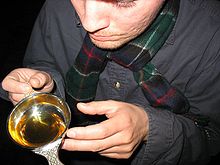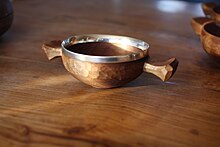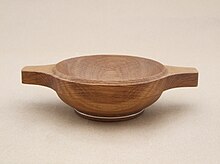| Revision as of 01:35, 28 November 2011 editRich Farmbrough (talk | contribs)Edit filter managers, Autopatrolled, Extended confirmed users, File movers, Pending changes reviewers, Rollbackers, Template editors1,725,883 editsm Fix spelling Encyclopædia Britannica or similar; using AWB← Previous edit | Latest revision as of 06:58, 28 October 2024 edit undoWikiCleanerBot (talk | contribs)Bots928,066 editsm v2.05b - Bot T20 CW#61 - Fix errors for CW project (Reference before punctuation)Tag: WPCleaner | ||
| (65 intermediate revisions by 49 users not shown) | |||
| Line 1: | Line 1: | ||
| {{Short description|Two-handed drinking vessel from Scotland}} | |||
| {{Refimprove|date=March 2011}} | |||
| {{Lead too short|date=January 2023}} | |||
| ] | ] | ||
| <!-- Unsourced image removed: ] --> | <!-- Unsourced image removed: ] --> | ||
| A '''quaich''' |
A '''quaich''' {{IPAc-en|ˈ|k|w|eɪ|x}}, ] '''quaigh''' or '''quoich''', is a special kind of shallow two-handled ] ] or ] of a type traditional in ]. It derives from the ] {{wikt-lang|gd|cuach}} ({{IPA-gd|kʰuəx}}), meaning a cup. | ||
| ==History== | |||
| According to the ], the quaich was inspired by the low silver bowls with two flat handles frequently used as bleeding vessels in ] and the ] in the 17th century. | According to the ], the quaich was inspired by the low ] bowls with two flat handles frequently used as ] in ] and the ] in the 17th century.{{sfn|Jones|1911|p=708}} | ||
| Another popular theory suggests that the shape is derived from scallop shells. However, this seems to have had its origins in the |
Another popular theory suggests that the shape is derived from ]. However, this seems to have had its origins in the poems of ] which were once thought to be translations of poems by ], son of ]. | ||
| ⚫ | In his 1955 monograph |
||
| ⚫ | In his 1955 ] ''Some Scottish Quaichs'',{{sfn|McClenahan|1955|p=3}} Richard L. McClenahan, an American collector, suggests that the quaich evolved directly from the medieval ]. This seems unlikely as the form and material (] for mazers) are quite different. There were small ] drinking vessels common in the medieval period found around the Baltics and, since some of the earliest quaichs are stave-built, this could be the source.] | ||
| ⚫ | Traditionally quaichs are made of wood, an artform known as "]". Some early quaichs are stave-built like barrels and some have alternating light and dark staves. The staves are held together by bands of willow or silver. They generally have two, and more rarely three or four, short, projecting handles. Other wooden quaiches were lathe-turned out of a single piece of wood and there was another group which were turned then carved outside in basket-weave pattern. In addition to wood, they are made of stone, brass, ], horn, and ]. The latter were often engraved with lines and bands in imitation of the staves and hoops of the wooden quaichs. ] | ||
| ⚫ | Traditionally quaichs are made of wood, an artform known as "]". Some early quaichs are stave-built like barrels and some have alternating light and dark staves. The staves are held together by bands of willow or silver. They generally have two, and more rarely three or four, short, projecting handles. Other wooden quaiches were lathe-turned out of a single piece of wood and there was another group which were turned then carved outside in basket-weave pattern. In addition to wood, they are made of stone, brass, ], horn, and ]. The latter were often engraved with lines and bands in imitation of the staves and hoops of the wooden quaichs.{{sfn|Jones|1911|p=708}} ] | ||
| ⚫ | The origin of quaichs in Scotland is traced to the Highlands{{ |
||
| ⚫ | The origin of quaichs in Scotland is traced to the Highlands;<ref>{{cite book|title=Living with Jacobitism, 1688–1760|first=Jennifer|last=Novotny|isbn=9781781440902}}</ref> it was not until the end of the 17th century that they became popular in such large centres as Edinburgh and Glasgow. The silversmiths of such local guilds as Inverness and Perth frequently mounted them in silver, as may be seen from the hallmarks on the existing examples.{{sfn|Jones|1911|p=708}} | ||
| ⚫ | Commemorative quaichs awarded as prizes, or given as gifts, are more commonly made of pewter or silver. These prize cups are rarely used for actual drinking. | ||
| ⚫ | Commemorative quaichs awarded as prizes, or given as gifts, are more commonly made of pewter or silver. These prize cups are rarely used for actual drinking.{{sfn|Jones|1911|p=708}} | ||
| Related vessels to the Scottish quaich include the ], a larger vessel typically {{convert|6|in|cm}} in diameter with one (US colonial) or two (European) horizontal handles. The ] and ], ], equivalent is the ], which also only has a single handle. | Related vessels to the Scottish quaich include the ], a larger vessel typically {{convert|6|in|cm}} in diameter with one (US colonial) or two (European) horizontal handles. The ] and ], ], equivalent is the ], which also only has a single handle. | ||
| The quaich was used for ] or ], and in the 19th century Sir ] dispensed ] in silver quaichs, |
The quaich was used for ] or ], and in the 19th century Sir ] dispensed ] in silver quaichs. One of the quaichs he owned was the ]. It was made in part from wood Scott had taken from the ], when he visited the battlefield shortly after the ] (the elm tree had been the ] command post for much of the battle).{{sfn|The Scotsman's staff|2010}} In his collection he also owned some other quaichs made from commemorative wood: one made from Falkland Oak; one made from Queen Mary's yew; and another made from the Wallace Oak.{{sfn|The Herald staff|1994}} The one he kept for himself was made of wood with seven bands, and had travelled from ] to ] with ] in 1745.{{sfn|The Herald staff|1994}} | ||
| Wooden commemorative quaichs designed by Paul Hodgkiss were given as presents to winners at the ] in Glasgow.{{sfn|BBC staff|2014}} | |||
| In 1745 the quaich had travelled from ] to ] with the Scottish Army in ]'s canteen. | |||
| ==See also== | |||
| Some quaichs' bottoms are made of glass, allegedly so that the drinker could keep watch on his companions. A more romantic quaich had a double glass bottom in which was kept a lock of hair so that the owner could drink from his quaich to his lady love, and, in 1589, ] gave ] a quaich or "]" as a wedding gift{{Citation needed|reason=reliable source needed for the whole sentence – is it recorded as quaich or loving cup?|date=January 2011}}. | |||
| ⚫ | * ] | ||
| ⚫ | * ] | ||
| ⚫ | * ] – a rugby football competition | ||
| ==Notes== | ==Notes== | ||
| {{Reflist}} | {{Reflist}} | ||
| == |
== References == | ||
| *{{citation |author=BBC staff|date=25 July 2014 |url=https://www.bbc.co.uk/news/uk-scotland-28481332 |title=Glasgow 2014: A quaich guide to the medallists' truly Scottish gifts |publisher=BBC News |access-date=31 July 2014}} | |||
| ⚫ | * ] | ||
| *{{citation |author=The Herald staff |date=21 April 1994 |title=Priceless heirlooms lost from Scott's home. Thieves take Abbotsford treasures |newspaper=] |url=http://www.heraldscotland.com/news/12675762.Priceless_heirlooms_lost_from_Scott_apos_s_home___Thieves_take_Abbotsford_treasures/ }} | |||
| ⚫ | * ] – a rugby football competition | ||
| *{{citation |last=McClenahan |first=Richard L. |year=1955 |title=Some Scottish Quaichs |location=Illinois |page=3}} | |||
| *{{citation |author=The Scotsman's staff |date=18 March 2010 |title=Sir Walter Scott |website=The Scotsman |url=http://www.scotsman.com/news/sir-walter-scott-s-stolen-waterloo-tree-quaich-returned-1-795376 |access-date=7 July 2015}} | |||
| '''Attribution:''' | |||
| * {{EB1911 |last=Jones |first=E. Alfred |wstitle=Quaich |volume=22 |page=708}} | |||
| ==External links== | ==External links== | ||
| {{Commons category|Quaiches}} | |||
| * | * | ||
| * {{dead link|date=July 2016 |bot=InternetArchiveBot |fix-attempted=yes }} | |||
| {{1911}} | |||
| ⚫ | ] | ||
| ⚫ | ] | ||
| ] | ] | ||
| ⚫ | ] | ||
| ⚫ | ] | ||
| ⚫ | ] | ||
| ] | |||
Latest revision as of 06:58, 28 October 2024
Two-handed drinking vessel from Scotland| This article's lead section may be too short to adequately summarize the key points. Please consider expanding the lead to provide an accessible overview of all important aspects of the article. (January 2023) |

A quaich /ˈkweɪx/, archaically quaigh or quoich, is a special kind of shallow two-handled drinking cup or bowl of a type traditional in Scotland. It derives from the Scottish Gaelic cuach (Scottish Gaelic pronunciation: [kʰuəx]), meaning a cup.
History
According to the 1911 Encyclopædia Britannica, the quaich was inspired by the low silver bowls with two flat handles frequently used as bleeding vessels in England and the Netherlands in the 17th century. Another popular theory suggests that the shape is derived from scallop shells. However, this seems to have had its origins in the poems of James Macpherson which were once thought to be translations of poems by Ossian, son of Fionn mac Cumhaill.
In his 1955 monograph Some Scottish Quaichs, Richard L. McClenahan, an American collector, suggests that the quaich evolved directly from the medieval mazer. This seems unlikely as the form and material (burr maple for mazers) are quite different. There were small stave-built drinking vessels common in the medieval period found around the Baltics and, since some of the earliest quaichs are stave-built, this could be the source.

Traditionally quaichs are made of wood, an artform known as "treen". Some early quaichs are stave-built like barrels and some have alternating light and dark staves. The staves are held together by bands of willow or silver. They generally have two, and more rarely three or four, short, projecting handles. Other wooden quaiches were lathe-turned out of a single piece of wood and there was another group which were turned then carved outside in basket-weave pattern. In addition to wood, they are made of stone, brass, pewter, horn, and silver. The latter were often engraved with lines and bands in imitation of the staves and hoops of the wooden quaichs.

The origin of quaichs in Scotland is traced to the Highlands; it was not until the end of the 17th century that they became popular in such large centres as Edinburgh and Glasgow. The silversmiths of such local guilds as Inverness and Perth frequently mounted them in silver, as may be seen from the hallmarks on the existing examples.
Commemorative quaichs awarded as prizes, or given as gifts, are more commonly made of pewter or silver. These prize cups are rarely used for actual drinking.
Related vessels to the Scottish quaich include the porringer, a larger vessel typically 6 inches (15 cm) in diameter with one (US colonial) or two (European) horizontal handles. The Sami and Norrland, Sweden, equivalent is the kuksa, which also only has a single handle.
The quaich was used for whisky or brandy, and in the 19th century Sir Walter Scott dispensed drams in silver quaichs. One of the quaichs he owned was the Waterloo Tree Quaich. It was made in part from wood Scott had taken from the Waterloo Elm, when he visited the battlefield shortly after the Battle of Waterloo (the elm tree had been the Duke of Wellington's command post for much of the battle). In his collection he also owned some other quaichs made from commemorative wood: one made from Falkland Oak; one made from Queen Mary's yew; and another made from the Wallace Oak. The one he kept for himself was made of wood with seven bands, and had travelled from Edinburgh to Derby with Bonnie Prince Charlie in 1745.
Wooden commemorative quaichs designed by Paul Hodgkiss were given as presents to winners at the 2014 Commonwealth Games in Glasgow.
See also
- Loch Quoich
- Glen Quaich
- Centenary Quaich – a rugby football competition
Notes
- ^ Jones 1911, p. 708.
- McClenahan 1955, p. 3.
- Novotny, Jennifer. Living with Jacobitism, 1688–1760. ISBN 9781781440902.
- The Scotsman's staff 2010.
- ^ The Herald staff 1994.
- BBC staff 2014.
References
- BBC staff (25 July 2014), Glasgow 2014: A quaich guide to the medallists' truly Scottish gifts, BBC News, retrieved 31 July 2014
- The Herald staff (21 April 1994), "Priceless heirlooms lost from Scott's home. Thieves take Abbotsford treasures", The Herald
- McClenahan, Richard L. (1955), Some Scottish Quaichs, Illinois, p. 3
{{citation}}: CS1 maint: location missing publisher (link) - The Scotsman's staff (18 March 2010), "Sir Walter Scott", The Scotsman, retrieved 7 July 2015
Attribution:
 This article incorporates text from a publication now in the public domain: Jones, E. Alfred (1911). "Quaich". In Chisholm, Hugh (ed.). Encyclopædia Britannica. Vol. 22 (11th ed.). Cambridge University Press. p. 708.
This article incorporates text from a publication now in the public domain: Jones, E. Alfred (1911). "Quaich". In Chisholm, Hugh (ed.). Encyclopædia Britannica. Vol. 22 (11th ed.). Cambridge University Press. p. 708.